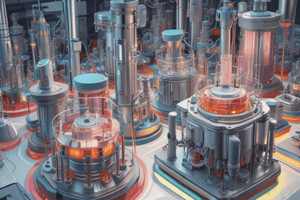Podcast
Questions and Answers
What is the primary function of the cathode in an X-ray tube?
What is the primary function of the cathode in an X-ray tube?
- To focus electrons onto the anode
- To accelerate electrons towards the anode
- To produce X-rays
- To generate electrons through thermionic emission (correct)
What is the purpose of the tungsten filament coils in the cathode?
What is the purpose of the tungsten filament coils in the cathode?
- To accelerate electrons towards the anode
- To generate heat for thermionic emission (correct)
- To produce X-rays
- To focus electrons onto the anode
Why is tungsten used for the filament coils?
Why is tungsten used for the filament coils?
- Because it has a low atomic number
- Because it is cheap and abundant
- Because it can be machined into thin coils with high surface area, high melting point, and is a good thermionic emitter (correct)
- Because it has a low melting point
What is the function of the focusing cap?
What is the function of the focusing cap?
What is a benefit of using biased focusing caps?
What is a benefit of using biased focusing caps?
What is the result of accelerating electrons towards the anode?
What is the result of accelerating electrons towards the anode?
What is the typical material used to make focusing caps?
What is the typical material used to make focusing caps?
What is the primary mechanism by which the anode copes with heat?
What is the primary mechanism by which the anode copes with heat?
What is the purpose of angling the anode in an X-ray tube?
What is the purpose of angling the anode in an X-ray tube?
What can be adjusted to change the size of the focal spot?
What can be adjusted to change the size of the focal spot?
What is the primary method of heat removal from the anode?
What is the primary method of heat removal from the anode?
What is the primary material used to make the anode?
What is the primary material used to make the anode?
What can be adjusted to balance image quality needs with heat production at the anode?
What can be adjusted to balance image quality needs with heat production at the anode?
Flashcards are hidden until you start studying
Study Notes
- The cathode is the negative electrode in an X-ray tube responsible for producing electrons through thermionic emission.
- Electrons produced at the cathode are accelerated towards the anode when a voltage is applied across the tube, leading to the generation of x-rays.
- The cathode contains tungsten filament coils that are machined into the face of the cathode, allowing for the production of electrons on its surface through thermionic emission.
- Thermionic emission works by running a current through the tungsten filament coils, generating heat that excites valence electrons to the surface, making them available for acceleration.
- Tungsten is used for the filament coils due to its ability to be machined into thin coils with high surface area, high melting point, and being a good thermionic emitter with a high atomic number.
- The focusing cap, usually made of molybdenum or nickel, helps focus electrons onto a smaller area on the anode to create a more defined focal spot for better image quality.
- Focusing caps can be unbiased or biased, with biased caps allowing for independent control over the focus of electrons without needing to release more electrons.
Studying That Suits You
Use AI to generate personalized quizzes and flashcards to suit your learning preferences.




